Mechanics' institutes
Mechanics' institutes are educational establishments, originally formed to provide adult education, particularly in technical subjects, to working men. Similar organisations are sometimes simply called "institutes". As such, they were often funded by local industrialists on the grounds that they would ultimately benefit from having more knowledgeable and skilled employees (such philanthropy was shown by, among others, Robert Stephenson, James Nasmyth, John Davis Barnett and Joseph Whitworth). The mechanics' institutes were used as "libraries" for the adult working class, and provided them with an alternative pastime to gambling and drinking in pubs.

Origins and history
The world's first mechanics' institute was established in Edinburgh, Scotland, in October 1821 as the School of Arts of Edinburgh (later Heriot-Watt University), with the provision of technical education for working people and professionals. Its purpose was to "address societal needs by incorporating fundamental scientific thinking and research into engineering solutions". The school revolutionised access to education in science and technology for ordinary people.
The second institute in Scotland was incorporated in Glasgow in November 1823, built on the foundations of a group started at the turn of the previous century by George Birkbeck. Under the auspices of the Andersonian University (est. 1796), Birkbeck had first instituted free lectures on arts, science and technical subjects in 1800. This mechanics' class continued to meet after he moved to London in 1804, and in 1823 they decided to formalise their organisation by incorporating themselves as the Mechanics' Institute.
The first mechanics' institute in England was opened at Liverpool in July 1823.[1] The London Mechanics' Institute (later Birkbeck College) followed in December 1823, and the mechanics' institutes in Ipswich and Manchester (later to become UMIST) in 1824.[2] By the mid-19th century, there were over 700 institutes in towns and cities across the UK and overseas, some of which became the early roots of other colleges and universities. For example the University of Gloucestershire, which has the Cheltenham Mechanics' Institute (1834) and Gloucester Mechanics' Institute (1840) within its history timeline. It was as a result of delivering a lecture series at the Cheltenham Mechanics' Institute that the radical George Holyoake was arrested and then convicted on a charge of blasphemy.[3][4]
In Australia, the first mechanics' institute was established in Hobart in 1827, followed by the Sydney Mechanics' School of Arts[5] in 1833, Newcastle School of Arts in 1835, then the Melbourne Mechanics' Institute established in 1839 (renamed the Melbourne Athenaeum in 1873). From the 1850s, mechanics' institutes quickly spread throughout Victoria wherever a hall, library or school was needed. Over 1200 mechanics' institutes were built in Victoria and just over 500 remain today, and only six still operate their lending library services.[6]
.jpg.webp)
The Industrial Revolution created a new class of reader in Britain by the end of the 18th century, "mechanics", who were civil and mechanical engineers in reality. The Birmingham Brotherly Society was founded in 1796 by local mechanics to fill this need, and was the forerunner of mechanics' institutes, which grew in England to over seven hundred in number by 1850.[7]
G. Jefferson explains that:
The first phase, the Mechanics Institute movement, grew in an atmosphere of interest by a greater proportion of the population in scientific matters revealed in the public lectures of famous scientists such as Faraday. More precisely, as a consequence of the introduction of machinery a class workmen emerged to build, maintain and repair, the machines on which the blessing of progress depended, at a time when population shifts and the dissolving influences of industrialization in the new urban areas, where these were concentrated, destroyed the inadequate old apprentice system and threw into relief the connection between material advancement and the necessity of education to take part in its advantages.[8]
Small tradesmen and workers could not afford subscription libraries, so for their benefit, benevolent groups and individuals created mechanics' institutes that contained inspirational and vocational reading matter, for a small rental fee. Later popular non-fiction and fiction books were added to these collections. The first known library of this type was the Birmingham Artisans' Library, formed in 1823.
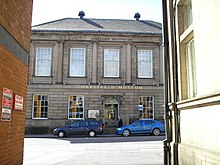
Some mechanics' libraries lasted only a decade or two, many eventually became public libraries or were given to local public libraries after the Public Libraries Act 1850 passed. Though use of the mechanics' libraries was limited, the majority of the users were favourable towards the idea of free public libraries.[9]
Beyond a lending library, mechanics' institutes also provided lecture courses, laboratories, and in some cases contained a museum for the members' entertainment and education. The Glasgow Institute, founded in 1823, not only had all three, it was also provided free light on two evenings a week from the local gas light company. The London Mechanics' Institute installed gas illumination by 1825, revealing the demand and need for members to use the books.[7]
Existing
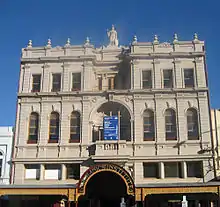

Thousands of mechanics' institutes still operate throughout the world—some as libraries, parts of universities, adult education facilities, theatres, cinemas, museums, recreational facilities, or community halls.
Australia
- Amphitheatre Mechanics' Institute, Amphitheatre
- Ballarat Mechanics' Institute, Ballarat
- Berwick Mechanics' Institute, Berwick
- Briagolong Mechanics' Institute, Briagolong
- Footscray Mechanics' Institute Inc. Library[10]
- Kilmore Mechanics' Institute and Free Library
- Kyneton Mechanics' Institute[11]
- Lancefield Mechanics' Institute and Free Library
- Little River Mechanics' Institute, Little River
- Maldon Athenaeum, Maldon
- Melbourne Athenaeum
- Narre Warren Mechanics Institute (1891)
- Prahran Mechanics' Institute
- Purlewaugh Mechanics' Institute
- Purnim Mechanics' Institute, Purnim
- Mechanics' Institute, Sorrento
- Sydney Mechanics' School of Arts
- Romsey Mechanics Institute[12]
- Richmond School of Arts[13]
- Guildford Soldiers Memorial School of Arts[14]
- Cronulla School of Arts
- Carlton School of Arts hall[15]
- Sunny Corner School of Arts.[16]
- Cookamidgera Mechanics Institute.
- Warrandyte Mechnanics' Institute, Warrandyte[17]
- Wambat Mechanics Institute.
Canada
- Atwater Library of the Mechanics' Institute, Montreal, Quebec
United Kingdom
Lincolnshire
- Epworth Mechanics Institute, North Lincs, UK,[18]
Yorkshire
- Bradford Mechanics' Institute Library 76 Kirkgate, BD1 1SZ
- Marsden Mechanics Institute, Marsden, West Yorkshire, HD7 6BW,[19] now a rental hall and public library
United States
Historical
Australia
- New South Wales
- Albury Mechanics' Institute
- The Blacktown Mutual Improvement Association, (1905)[20]
- Carlingford Mechanics' Institute[21]
- Kogarah School of Arts (1886)[22]
- Lawson Mechanics' Institute
- Moruya Mechanics' Institute[23]
- Oatley School of Arts (1905)
- Penrith Mechanics' Institute
- Victoria
- Ballaarat Mechanics' Institute
- Berwick Mechanics' Institute
- Footscray Mechanics' Institute Inc. Library
- Maldon Athenaeum, Maldon[24]
- Melbourne Athenaeum
- Melbourne mechanics institute[25] now part of the Victorian state library
- Prahran Mechanics' Institute,[26] 1854, the only Mechanics’ Institute in Victoria which has its own Act of Parliament for its incorporation.[27]
- Briagolong Mechanics' Institute, Briagolong
- Ballarat Mechanics' Institute[28] Ballarat
- Berwick Mechanics' Institute, Berwick.[29] 1862
- Ballan Mechanics Institute, 1860[30]
- Binalong, Victoria Mechanics Institute
- Bonnie Doon
- Brunswick, Victoria Mechanics Institute* Briagolong Mechanics’ Institute, 1874
- Bunyip Mechanics’ Institute 1905
- Footscray Mechanics' Institute Inc. Library[10]
- Burke and Wills Institute, Fryertown Victoria[31]
- Charlton, Mechanics Institute
- Drysdale Free Library
- Elmhurst Mechanics Institute
- Echuca Mechanics' Institute, Victoria
- Geelong Mechanics Institute
- Glengarry Mechanics’ Institute,1886
- Great Western Mechanics Institute
- Horsham, Mechanics Institute
- Healesville Mechanics Institute
- Kilmore Mechanics' Institute and Free Library
- Kyneton Mechanics Institute[11]
- Lancefield Mechanics' Institute and Free Library (est. 1868)
- Little River Mechanics' Institute, Little River[32]

- Long Gully Mechanics Institute
- Longwarry Mechanics' Institute and Free Library, 1886
- Leongatha Mechanics Institute
- Lilydale Mechanics Institute
- Malmsbury Mechanics' Institute, 1862
- Meeniyan Mechanics' Institute, 1892
- Moonambel Mechanics' Institute
- Mornington Mechanics Institute
- Morongla Creek Mechanics Institute Hall
- Murrumburrah#gallery Institute
- Macarthur, Victoria Mechanisc Institute Hall
- Nagambie Mechanics Institute
- Narre Warren Mechanics Institute (1891)
- Prahran Mechanics' Institute
- Purlewaugh Mechanics' Institute
- Purnim Mechanics' Institute, Purnim
- Port Fairy Library and Lecture Hall, 1860
- Mechanics' Institute, Sorrento
- Romsey Mechanics Institute[12]
- Riddells Creek Mechanics Institute
- Rosedale Mechanics' Institute , 1863
- Rushworth Mechanics Institute
- Stanley Athenaeum and Public Room
- Stratford Mechanics' Institute., 1866
- Talbot Community Library & Arts Centre
- Trafalgar Mechanics' Institute and Free Library, 1889
- Toongabbie Mechanics' Institute, 1883
- Warrandyte Mechnanics' Institute, Warrandyte[17]
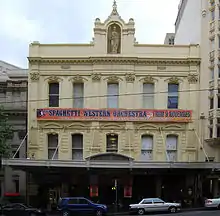
- Wiiliamstown Mechanics Institute

- Ballarat Mechanics Institute
- Ballan Mechanics Institute
- Charlton, Mechanics Institute
- Drysdale Free Library
- Elmhurst Mechanics Institute
- Echuca Mechanics' Institute, Victoria
- Great Western Mechanics Institute
- Healesville Mechanics Institute
- Kyneton Mechanics Institute
- Horsham, Mechanics Institute
- Leongatha Mechanics Institute
- Lilydale Mechanics Institute
- Moonambel Mechanics Institute
- Mornington Mechanics Institute
- Morongla Creek Mechanics Institute Hall
- Murrumburrah#gallery Institute
- Macarthur, Victoria Mechanisc Institute Hall
- Nagambie Mechanics Institute
- Riddells Creek Mechanics Institute
- Rushworth Mechanics Institute
- Mechanics' Institute, Sorrento
- Merton Mechanics' Institute

- Winiam, Shire of Lowan Mechanis Institute Library
- Woodend Mechanics Institute
- Yandoit Mechanics Institute
- Queensland
- Baree School of Arts
- Brisbane School of Arts
- Bundaberg School of Arts
- Cairns School of Arts (now the Cairns Museum)
- Coorparoo School of Arts
- Eumundi School of Arts (now the Eumundi and District Historical Association)
- Gympie School of Arts (now the Gympie Regional Gallery)
- Herberton School of Arts
- Irvinebank School of Arts Hall
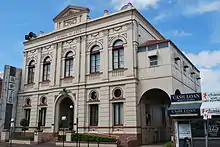
_(2002).jpg.webp)
- Rockhampton School of Arts
- Townsville School of Arts
- Woody Point Memorial Hall
- Yangan School of Arts
- South Australia
- Adelaide Mechanics' Institute (1838, then 1847–), which later developed into the South Australian Museum and State Library of South Australia
- Curramulka Institute
- Edithburgh Institute
- Balaklava Institute Hall
- Beachport, South Australia Institute
- Cambrai, South Australia Institute
- Cobdogla Institute
- Coonalpyn Institute
- Dawson Mechanics Institute
- Dublin Institute
- Freeling Institute
- Farrell Flat Institute
- Hamley Bridge Institute
- Owen Institute
- Karoonda Institute

- Macclesfield Institute
- Mannum Institute
- Mintaro Institute
- Mitcham Institute
- Morgan Institute
- Mount Gambier Institute
- Nackara Institute
- Pinaroo Institute
- Pine Point Memorial Institute
- Port Vincent Institute
- Ramco Institute
- Saddleworth Institute
- Stansbury Memorial Institute
- Terowie Institute and Council Chamber
- Waikerie Institute
- Wasleys Institute
- Western Australia
- Swan River Mechanics' Institute
- South Perth Old Mill Theatre
- Guildford Mechanics Institute
- Toodyay Mechanics Institute
- Mechanics Institute of West Australia
- Tasmania
- Mechanics' Institute Launceston, Tasmania, Australia
- Van Diemen's Land Mechanics' Institute
- Huon Mechanics' Institute
- Hobart Mechanics' Institute
- West Hobart Mechanics' Institute
- Waratah Mechanics' Institute
- Port Esperance Mechanics' Institute
- Emu Bay Mechanics' Institute
- Ringarooma Mechanics' Institute
- Queenstown Mechanics' Institute
Canada
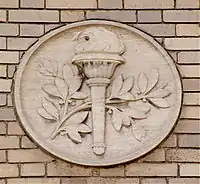

Atlantic provinces
Ontario
- Barrie Mechanics' Institute
- Brockville Mechanics' Institute, now Brockville Public Library[33]
- Bytown Mechanics' Institute, later Mechanics' Institute and Athenaeum of Ottawa, now Ottawa Public Library
- Elmsley Library Association and Mechanics' Institute
- Elora Mechanics' Institute
- Farmers' Mechanics' Institute of Streetsville
- Guelph Farmers' and Mechanics' Institute, now Guelph Public Library[34]
- Hamilton and Gore Mechanics' Institute
- Kingston Mechanics' Institute
- London Mechanics' Institute
- Mechanics' Institute, Coldstream
- Mechanics' Institute (Orillia)
- Mechanics' Institute of Goderich
- Mechanics' Institute of Point Edward
- Midland Railroad Mechanics' Institute
- Napanee Mechanics' Institute
- Newmarket Farmers' Mechanics' Institute
- Owen Sound Mechanics Institute
- Peterborough Mechanics' Institute
- St. Catharines Mechanics' Institute Library
- Toronto Mechanics' Institute
- Woodstock Mechanics' Institute
Quebec

- Montreal Mechanics Institute
- Quebec Mechanics' Institute
Hong Kong
New Zealand
- Auckland Mechanics' Institute, founded 30 September 1842, closed 1880, with transfer of all library content to Auckland City Council library.[35]
United Kingdom
(alphabetical order by town or city)
- Aberdeen Mechanics' Institute, Market Street, Aberdeen (architect Archibald Simpson), now a hotel.
- Alford Institute. Founded 1854.
- Boston. Founded in 1849, became the Boston Atheneum in 1855.
- Bradford Mechanics' Institute Library, Yorkshire
- Brechin Mechanics Institute, Angus
- Brentford Mechanics' Institution, Middlesex. Founded in 1835 and closed around 1890.[36][37]
- Burnley Mechanics, Burnley, Lancashire
- Darlington Mechanics Institute, built in 1854, as of 2014 a nightclub and bar.[38]
- School of Arts of Edinburgh, renamed to Heriot-Watt University in 1966
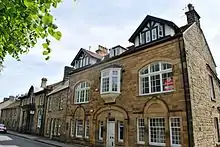
- Eyam, Derbyshire
- Essex
- Gainsborough. Room in Gainsborough Old Hall.
- Grimsby, Lincolnshire.Founded in 1835. new building in Victoria Street in 1856.
- Ipswich Institute, Suffolk – Ipswich Institute Website
- Horncastle, Lincolnshire
- Leeds Mechanics' Institute (West Yorkshire) designed by Cuthbert Brodrick, now Leeds City Museum
- Lincoln. Founded 1833 in the undercroft of the Greyfriars
- Liverpool Mechanics School of Arts, founded 1825, renamed Liverpool Mechanics Institution in 1832, which later became the Liverpool Institute High School for Boys and from 1996 the Liverpool Institute for Performing Arts.
- London Mechanics' Institute which eventually became Birkbeck, University of London
- Louth Founded 1835. Moved to Mansion House 1853.
- Lurgan, County Armagh. 69 Market Street.
- Lutterworth, Leicestershire
- Manchester, forerunner of University of Manchester Institute of Science and Technology, which merged with Victoria University of Manchester to form the University of Manchester
- Market Rasen,Lincolnshire Founded in 1836 in Queen Street
- Nottingham Mechanics Institute[39]
- University of South Wales, Newport – The old mechanics institute building was sold off and has been converted to private apartments.
- Otley, Yorkshire
- Royston, Hertfordshire, built 1855, later became the town hall and picture palace
- Spitalfields Mechanics' Institution, founded in early 1825 by Thomas Gibson, father of Thomas Field Gibson[40]
- Stamford, Lincolnshire, Stamford Institution. Founded 1842.
- Swindon Mechanics' Institute, Wiltshire
- Wolverhampton (Queen Street, c1835)[41]
United States
- 1792 The Mechanic Library Society of New Haven, Connecticut was founded. It was chartered the following year and was eventually superseded in New Haven by The Young Men's Institute Library.
- 1795 The Massachusetts Charitable Mechanic Association of Boston, Massachusetts, was "formed for the sole purposes of promoting the mechanic arts and extending the practice of benevolence."
- 1820 General Society of Mechanics and Tradesmen of the City of New York established. Renamed and became the Mechanics Institute in 1858.
- 1821 The English High School was established in Boston, MA, as the first public high school, with leadership from the Massachusetts Charitable Mechanic Association.
- 1824 "The Franklin Institute of the State of Pennsylvania for the Promotion of the Mechanic Arts" opened in Philadelphia.
- 1826 The Maryland Institute for the Promotion of the Mechanic Arts opened in Baltimore.
- 1827 Boston established a mechanics' institute.
- 1828 In Cincinnati, the Ohio Mechanics Institute (OMI) was founded on 20 November to "facilitate the diffusion of useful knowledge" to "ingenious artisans and mechanics".
- Richmond, Virginia – Mechanics' institute was located at 9th and Bank Streets[42] Marshall Street properties are now part of Virginia Commonwealth University[43] and Richmond Public Schools[44]
- Rochester, New York – 1885 mechanics' institute merged with the Rochester Athenium in 1891 to become the Rochester Athenaeum and Mechanics Institute. Renamed to Rochester Institute of Technology (RIT) in 1944.[45]
- Each state and territory has at least one land grant university that includes a college of agriculture and a college of engineering, as provided for by the Morrill Land-Grant Acts to teach agriculture, military tactics, and the mechanic arts as well as classical studies
Land-grant universities
For a full listing, refer to List of Land-Grant Universities
- Alabama Agricultural and Mechanical University
- Florida A&M University
- Louisiana State University and A&M College, commonly referred to as just "Louisiana State University"
- Southern University and A&M College
- Texas A&M University, the flagship institution of the Texas A&M University System
Community colleges
- Northeastern Oklahoma A&M College, a community college
Mechanics' Worldwide Conferences
Four conferences have been held on mechanics' institutes:
- Buildings, Books and Beyond: Mechanics' Worldwide (2004) by the Prahran Mechanics' Institute at Prahran, Victoria, Australia.[46]
- Self Help: Mechanics' Worldwide (2009) by the Bath Royal Literary and Scientific Institution at Bath, Somerset, England.[47]
- Buildings, Books and Blackboards:Intersecting Narratives (2012) A combined conference of the Australian and New Zealand History of Education Society (ANZHES), Mechanics' Institutes Worldwide (under the auspices of MIV) and incorporating the 10th Library history forum.
- Reinvention: Thriving in the 21st Century - International Conference of Independent Libraries and Mechanics’ Institutes (2016) by San Francisco Mechanics' Institute [48]
The fifth conference is planned for 2021 in Edinburgh, Scotland.
References
- Speeches of Henry, Lord Brougham Vol. II, 1841, Lea and Blanchard, Philadelphia
- Kidd, Alan J. (1993). Manchester (Town and city histories). Manchester: Ryburn. pp. 57–8. ISBN 1-85331-016-6.
- Politics in Mechanics' Institutes 1820–1850, Turner, C M, Thesis (PhD), 1980 (thesis). Turner, C. M., Leicester University. January 1980. hdl:2381/35680.
- "Notes of Mr Hunt reporter August 15 1842, The Trial of George Jacob. Holyoake on an Indictment for blasphemy". British Library main catalogues. British Library.
- "SMSA (Sydney Mechanics' School of Arts)". SMSA.
- Lowden, Bronwyn (2010). Mechanics' Institutes, Schools of Arts, Athenaeums, etc.: An Australian Checklist – 3rd Edition. Donvale, Australia: Lowden Publishing Co. pp. 64–111. ISBN 978-1-920753-16-0.
- Kilgour, Frederick, The Evolution of the Book. New York, Oxford: Oxford University Press, 1998, p. 99.
- Jefferson, G.. Libraries and Society. Cambridge & London, Great Britain: James Clark & CO. LTD., 1969, p. 21.
- Harris, Michael. History of Libraries in the Western World. 4th ed. Metuchen, N.J.: Scarecrow Press, 1995, p. 153.
- "FMI Library". fmilibrary.org.
- "Kyneton Mechanics Institute". mrsc.vic.gov.au. Archived from the original on 27 December 2014. Retrieved 27 December 2014.
- Romsey Mechanics Institute
- Trove.
- Sydney Morning Herald 9 October 1933 page 6.
- Catherine Freyne, 2010 The School of Arts movement.
- Sunny Corner School of Arts Trust.
- "The Warrandyte Mechanics Institute Hall". WMIAA. WMIAA. Retrieved 8 October 2015.
- Epworth Mechanics Institute Archived 25 April 2013 at the Wayback Machine
- "Marsden Mechanics".
- Freyne, Catherine. The School of Arts movement. Sydney Mechanics' School of Arts, 2010.
- Cumberland Argus and Fruitgrowers Advocate, 3 June 1922, p.8.
- Morris, Roger. 'Sydney suburban Schools of Arts: From and for the community' in Schools of Arts and Mechanics' Institutes: From and for the community – Proceedings of a National Conference, University of Technology, Sydney, 2002, p.79.
- "Mechanics Institute". New South Wales State Heritage Register. Office of Environment and Heritage. H00485. Retrieved 18 May 2018.
- Maldon Athenaeum Library
- Chris Healy, From the Ruins of Colonialism: History as Social Memory (CUP, 1997) page 204.
- Mechanics’ Institutes March 29, 2017 | historicalragbag.
- These Walls Speak Volumes: A history of Mechanics’ Institutes in Victoria by Pam Baragwanath and Ken James ISBN 9780992308780
- Ballaarat Mechanics' Institute.
- Berwick Mechanics Institute and Free Library
- Mechanics’ Institutes March 29, 2017 | historicalragbag .
- A History of Mechanics' Institute Libraries.
- Little River Mechanics' Institute.
- "Brockville Public Library". ancestry.com.
- "Our History". Guelph Public Library. Archived from the original on 16 December 2012. Retrieved 15 October 2012.
- "LIANZA Conference" (PDF). LIANZA – Library and Information Association of New Zealand Aotearoa. 8 September 2004. Retrieved 5 January 2019.
- Faulkner, T. (1845). History and Antiquities of Brentford, Ealing, & Chiswick.
- Ronalds, B.F. (2018). "The Montgomrey Family of Brentford: Timber Merchants and Benefactors". London's Industrial Archaeology. 16: 57–69.
- Lloyd, Chris (10 March 2014). "HISTORY: School for rude mechanicals". The Northern Echo. Retrieved 11 May 2014.
- Nottingham Mechanics Institute
- A Course of Three Lectures on the Formation of a Spitalfields Mechanics' Institution. 1825.
- "Victorian Wolverhampton, a town though its buildings". Wolverhampton History & Heritage Website. Archived from the original on 1 June 2013. Retrieved 15 October 2012.
- "Mechanics' Institute". mdgorman.com.
- "Virginia Mechanics Institute Building – VCU Maps". vcu.edu.
- "Richmond Technical Center". richmond.k12.va.us.
- "A01.0 History, Accreditation and Legacy – University Policies – RIT". rit.edu. Archived from the original on 22 June 2013.
- Mechanics' Worldwide (2004) Buildings, Books and Beyond: Mechanics' Worldwide Conference 2009 – Proceedings of the first International Conference convened by the Prahran Mechanics' Institute. Prahran, Victoria, Australia: Prahran Mechanics' Institute. ISBN 0-9756000-1-X
- Mechanics' Worldwide 2009. (2009) Self Help: Mechanics' Worldwide Conference 2009 – Proceedings of the second International Conference convened by the Bath Royal Literary and Scientific Institution. Donvale, Victoria, Australia: Lowden Publishing Co. ISBN 978-1-920753-18-4
- "Reinvention: Thriving in the 21st Century -". www.milibrary.org. Retrieved 11 April 2018.
Further reading
- Kelly, Thomas (November 1952). "The Origin of Mechanics' Institutes". British Journal of Educational Studies. Society for Educational Studies. 1 (1): 17–27. doi:10.2307/3119430. JSTOR 3119430.
- Russell Rex C. (1994) Living and Learning in Lindsey, Lincolnshire: 1830-1890 - AHistory of Adult Education in North Lincolnshire. The University of Hull 1994. ISBN 0859580245.
